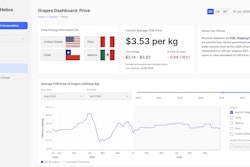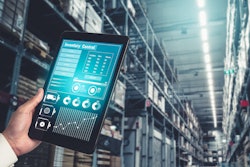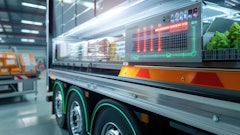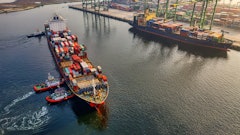
In the high-stakes world of food logistics, success is measured by more than just speed. Operators must balance accuracy, safety, and compliance—all while protecting high-value, perishable goods under increasing threat from theft, fraud, and disruption. Traditional security models—reliant on static cameras or guards with limited visibility—are no longer enough.
What’s emerging instead is a smarter, more connected approach: a hybrid system that combines site-specific technology and AI with trained remote agents who monitor, guide, and enforce protocols in real time. This isn't just about security—it’s about transforming the yard into a fully integrated operational hub.
A modern system captures everything from gate entries to load reconciliations and ties that data directly into transportation, warehouse, and yard management systems. The result is real-time visibility, better decisions, and measurable ROI. For food logistics providers, this all-in-one approach helps generate more revenue, manage risk more effectively, and reduce costs—turning a traditional expense into a strategic advantage.
The stakes: Perishable, valuable, vulnerable
Food cargo is uniquely exposed. It’s perishable, high-value, and often requires temperature control and strict chain-of-custody protocols. That makes it an ideal target for cargo theft and fraud, especially during high-friction moments like loading, parking, or route transitions.
Even beyond the risk of outright theft, food shipments are vulnerable to misrouting, documentation errors, and seal tampering. These errors don’t just slow down operations—they create compliance liabilities and put entire shipments at risk of spoilage or rejection.
Facilities that depend solely on systems that don’t talk to each other often miss critical context, resulting in delays, false alarms, and missed threats. That’s where the hybrid model becomes the game-changer. Gate data, yard management systems (YMS), security footage, operational workflows, and safety compliance tools all need to work in sync. When these systems are siloed, crucial information is lost. But when integrated, they create a unified operating picture that drives real-time decisions, reduces vulnerabilities, and ensures nothing falls through the cracks, especially in the fragile, high-risk environment of food logistics.
Intelligent gate management system: Where control begins
The modern smart yard starts at the gate—with an intelligent management system that combines AI, site-specific technology, and professionally trained remote agents to:
● Identify and record every individual and vehicle entering and exiting the facility.
● Reconcile driver credentials and load paperwork with a high degree of accuracy.
● Validate trailer seals visually and in real time.
● Inspect trucks and trailers for all damages big and small.
● Direct drivers to the appropriate drop zones or staging areas.
● Automatically link all captured data to TMS, YMS, WMS, or CRM platforms and provide real-time visibility for better-informed business decisions.
This integration goes far beyond the role of a traditional security guard. It ensures that every gate interaction is seamlessly linked to broader business operations. From appointment validation and inventory handoff to billing reconciliation, the gate becomes a command center for everything downstream.
With every event monitored and time-stamped, facilities gain a complete digital thread—supporting real-time decision-making and continuous operational improvement. This level of control and accountability builds trust with customers, strengthens your position when negotiating insurance rates, and leaves a lasting impression on drivers and visitors alike as gate processing times are significantly increased.
Cameras as operational eyes
In a logistics-specific remote supervision model, cameras go well beyond basic security—they act as operational eyes across the yard and warehouse. High-resolution AI-enabled feeds are monitored in real time by trained professionals who are familiar with the specific protocols of each site. This allows for active enforcement of critical procedures, including:
● Monitoring the back of trailers to ensure seals remain intact from arrival to departure.
● Verifying that cold storage trailers remain closed and maintain proper temperature compliance.
● Detecting unauthorized access to sensitive areas or idle assets.
● Ensuring all personnel adhere to PPE and safety protocols, such as pre-trip inspection enforcement via loudspeaker.
It’s only through real-time monitoring by site-aware professionals—not just motion detection or algorithmic triggers—that companies can truly enforce safety, security, and operational integrity without compromise.
AI alone isn’t enough
AI plays a critical role—it never sleeps, and it’s exceptionally good at detecting anomalies. But logistics operations require more than detection. They require interpretation and judgment, especially when compliance, safety, and operational timing are on the line.
An AI-only system might flag motion near a trailer after hours, but only a trained human can determine whether it’s a threat, an employee working overtime, or a maintenance technician responding to an urgent issue.
In a hybrid setup, a remote security professional views the footage in real time, cross-references access logs, and initiates a voice intervention through on-site speakers. If the individual is unauthorized, local law enforcement is contacted—often before any physical theft occurs. If it’s a legitimate actor, the situation is quickly de-escalated. No disruption, no delay.
Hybrid oversight that goes beyond security
What begins as a security solution quickly becomes an operational advantage that turns into higher sales and more business control. By merging intelligent detection with human expertise, logistics operators gain:
● Faster operational flow: Intelligent gate management systems are fast and can deliver 99.99% data accuracy. Drivers aren’t delayed by manual paperwork checks, or staging confusion.
● Fewer incidents: The presence of real-time oversight through the yard deters both external theft and internal shrinkage.
● Faster response times: Validated alerts mean the right people respond to real threats faster—minimizing loss and disruption.
● Lower insurance costs: With better incident documentation and fewer claims, premiums often decline.
● Data-driven decisions: Every event, entry, and transaction is recorded—feeding valuable insights into your TMS, WMS, or CRM systems.
And for FTL, 3PL and DC, the benefits go even further. Deploying this kind of hybrid security and supervision system becomes a competitive differentiator. By showcasing a process-driven, data-rich environment—complete with documented protocols, digital traceability, and real-time oversight—carriers can build trust with food shippers and prospective customers.
This transparency demonstrates operational discipline and security compliance, which can lead to increased business opportunities and long-term customer retention. In that sense, the system doesn’t just pay for itself—it drives growth.
The future is integrated, not automated
Security in food logistics has evolved from being a defensive cost center to a proactive, integrated business function. Today’s best practices pair AI-driven data with professional judgment, automation with oversight, and monitoring with real-time action.
Whether it's ensuring seal integrity, enforcing drop-zone discipline, or capturing driver logs at the gate with 99.99% accuracy, the hybrid integrated approach enables logistics operations to scale safely and confidently.
In a world where every second matters and every shipment counts, full-spectrum facility supervision—driven by AI and guided by humans—is no longer a luxury. It's the new baseline for food logistics.




















